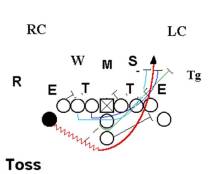Wingbuster: The Plan
Research – I used two invaluable resources. Former Tiger assistant football coach Wayne Link let us use his double wing offense book. Formations, plays, blocking schemes; this book had it all. It was like taking a college course in the double wing. Always helps to know the offense as well as possible before trying to find a defensive scheme to stop it.
The second resource I found on an internet search was a coaching site hosted by a football genius, Coach Bruce Eien, from California. His BC Warrior Coaching site had a plethora of resources on offense and defense. But, there was an obscure little document he wrote called Defending the Double Wing that is football intellect at its very best. Whatever success we had implementing the Wingbuster defense grew out of the principals in Coach Eien’s article.
THE PLAN
Double Wing Defense
Alignments
Mike 4-5-2

Dog 5-4-2

The Jobs
Defensive Tackles
The main cog in the defense is the DT. He might not make one play all night but he is vital to the defense. He rips through the OG/OT gap trying to get into the backfield. Most likely he will be double teamed. Both DT’s will cut through the knees of the OL and cut the double team. Drive low and through causing a pile up. The DT on the pulling side should try and cut the pulling OL. Minimally, he needs to impede the pulling OG/OT.
If he does not get the cut, pursue down the LOS looking for cut back. Keep an eye out for the TE blocking down or trying to cut you.
Defensive Ends
The DE lines up in a 9-technique and will cut through the outside knee of the tight end to a point 1.5 yards behind B gap. Drive through and cause a pile up by taking on the FB or pulling lineman. The DE must cause the pulling lineman and backs to loop around the pile they create.
Inside Linebackers
Alignment: 5 yard deep over the DT.
Assignment: Cross read the opposite wingback
If the cross wingback goes in motion:
Blitz C gap, wreck havoc, stay low and find ball.
If the cross wingback blocks down:
Drag the anchor and slow pursue looking for cutback right back at you.
If the cross wingback delays
Look for Reverse/Spin to your wingback coming right back at you. Blitz C gap and wreck havoc.
If you can, get a read on direction of the pulling OL helmets, they will take you to the play.
MIKE/DOG
The MIKE/DOG can play a vital role in disrupting this offense.
As the MIKE, he plays B gap to B gap, disrupting everything in his path. He will put a stop to the FB running plays and the Wingback on the cutback. MIKE will need to see the field and learn to read the pulling O-lineman’s helmets.
As the DOG, he might not make one play all night but he is vital to the defense. The DOG plays head up on the center and cuts low through the knee of the center to the play side A gap. We want the DOG to be as disruptive as humanly possible to the pulling lineman and backs. We determine play side by motion, best back, or tendencies. He rips through the center trying to get into the backfield. Depending on their blocking scheme he may come untouched into the backfield. Most likely he will be double teamed. Minimally, he needs to impede the pulling OG/OT.
OLB
The OLB are the key tackler’s in this defense. We want to funnel everything outside of the alleys in which they want to run. The design and strength of the play is inside behind a wall of blockers, so any back running outside is by himself , defeating the purpose of the play. The OLB uses a OLE’ technique, like a bull fighter, avoiding all contact.
The OLB needs to read the motion of the wing to their side.
If wing BLOCKS: Here it comes right at you. OLE to sift through bodies to find ball.
If wing MOTIONS: Slow blitz with a tight path and look for reverse or spin. If no reverse, scrape, looking for cutback. If reverse comes, use the OLE’ technique.
If wing DELAYS: It is reverse all the way to the other side. Yell “Reverse” and try to chase play down from backside.
Corners
The Corner reads his TE.
If the TE blocks: He becomes an alley player, filling the alley and containing RB if RB is forced wide.
If the TE cut blocks inside: Run play is going the other way, slow pursue looking for reverse/spin or cutback.
If he reads a pass release from the TE: He covers the deep ½ jumping a corner route by the TE, staying deeper than the deepest route in zone.
The two corners are the only players on the defensive unit that think: “Pass first, run second”.
This is a normal Toss play schematic, the toss is the foundation of the Double Wing offense.

Defensively, if every one does their job, this should happen.

We have a RB that has no where to go, running into his line. He ends up trying to bounce outside or falls over his own man. Sometimes, the RB bounces out to a open space. While this is usually a problem it is not with a double wing team.
The RB’s in the double Wing are used to running behind people. They are not open field runners. A usual scenario has our line taking out their line and the OLB’s end up making the tackle.
*Tg and R are OLB’s








